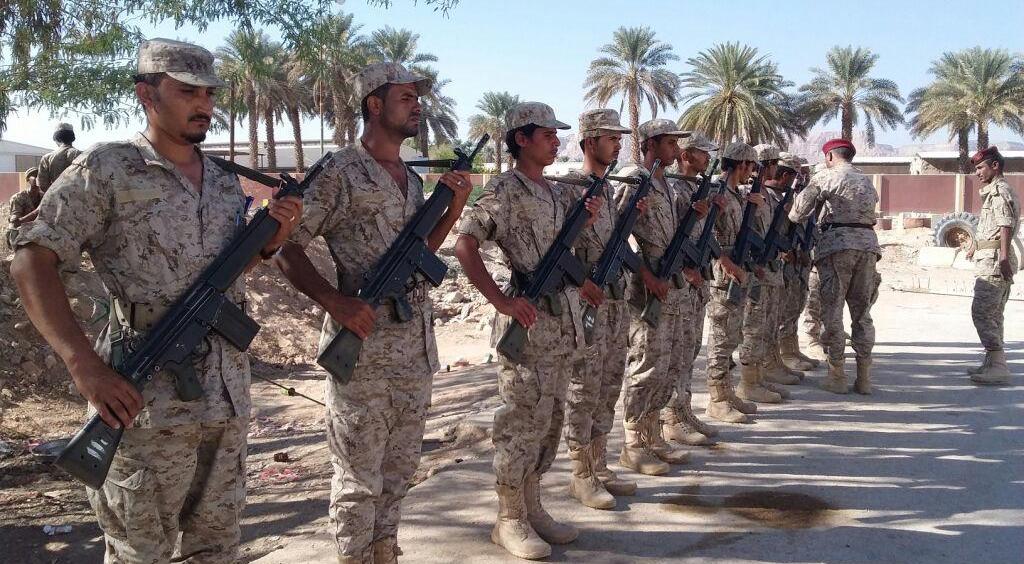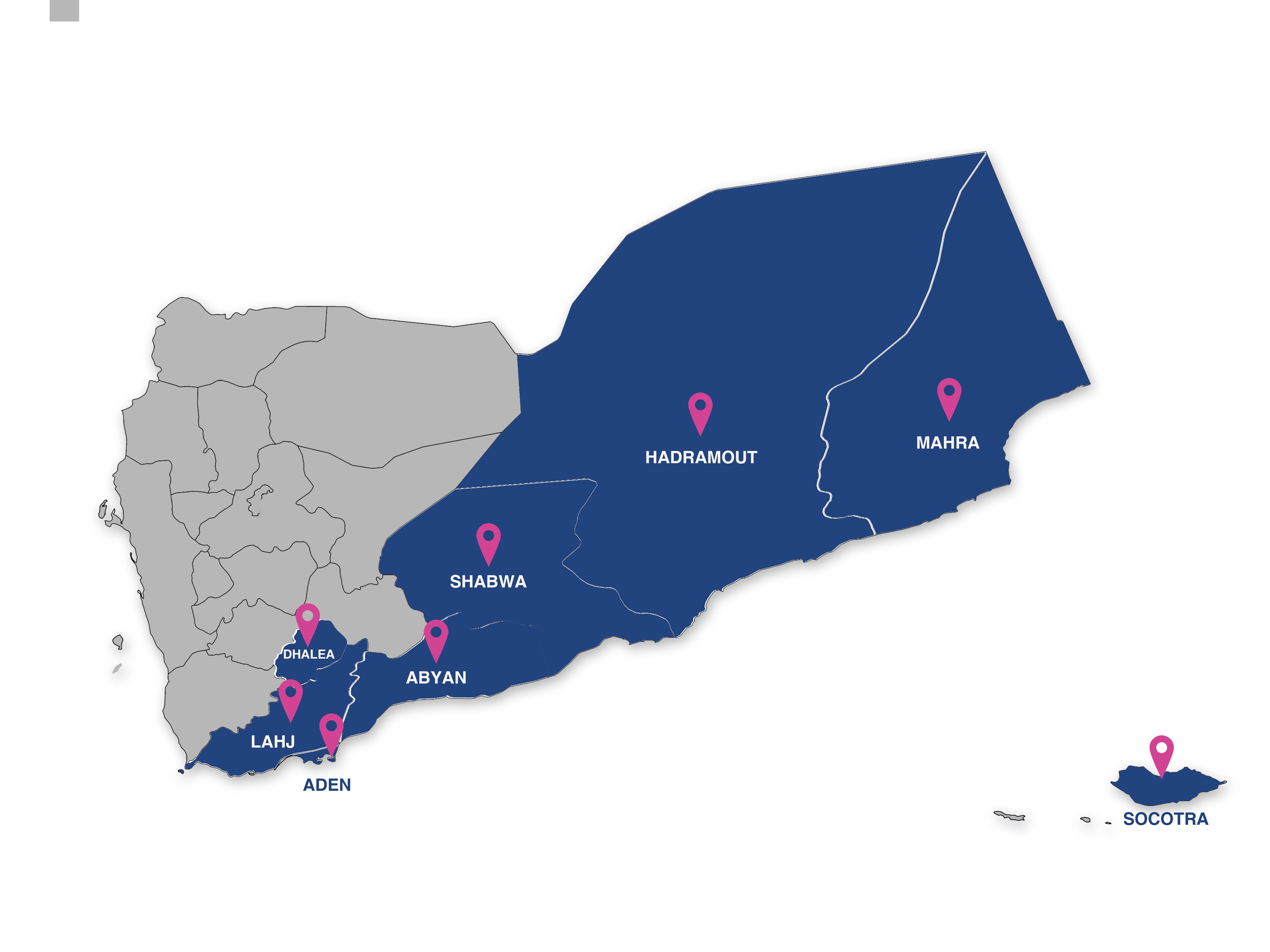
Members of the 1st Military District, November 2016 (local media)
Last updated on: 29-12-2022 at 5 PM Aden Time

Waddah Al-Oubali (South24)
The First Military District (FMD) is based in the Valley (Wadi) and Desert (Sahara) of Hadramout in South Yemen since the Republican Decision No. 16 for 2013. The latter decided to reshape and redeploy the military districts and the theaters of their operations. It determined the theater of the FMD operations [1] prior to the “Houthi coup” which led to a change of the locations of a number of military districts and their theaters of operations. This includes districts that were completely receded and were reshaped out of their usual operation theaters like what happened with the 6th and the 7th military districts which were established after 2015 in the same venue of the 3rd Military District in Marib.
The course of events and the harbingers of the troubled situation since 2015 have imposed necessities and changes. This obliged the leadership emanating from this period to accept dealing with it in light of what suits this stage and its priorities in a way that achieves the required harmony towards the main threats. For example, the circumstances which imposed reshaping military districts outside of their real venues - that have become under the Houthi control since they seized Sanaa - are the same circumstances which give PLC the possibility to move the FMD from Hadramout's Wadi and Sahara to the fronts of Marib, Al-Jawf and Al-Bayda to engage in the battle to regain the state.
Moreover, this would enhance the state of harmony with one of PLC's components which is STC and its popular bases in Hadramout. STC believes that the presence of the FMD in Hadramout aims at controlling this geography which has rich oil and mineral resources. Additionally, it extends across a wide area whose northern parts constitute about 40% of the overland borders with KSA.
For more clarification about the FMD, the table below reviews the most prominent military brigades there.
No. | Official name |
1 | the 23rd Mecha Brigade |
2 | The 37th Armored Brigade |
3 | The 135th Infantry Brigade |
4 | The 101st Air Police Brigade |
5 | The Military Police Branch of the FMD |
Positions, demands and pretexts
In the face of the demands to move it to the Northern fronts, the leadership of the FMD claims that its deployment there was determined by the aforementioned Republican decision which re-distributed and named the Military districts. According to it, its operational theater is limited to Hadramout’s Wadi and Sahara or north of Hadramout. It is an expanded geography which includes bumpy mountains, medium plateaus, valleys, and deserts but it has plenty of resources including oil and mineral wealth. There are doubts around it about the reality of its affiliation and the destination of its revenues.
From a logical point of view, some Yemeni parties believe that the Houthi coup against the state in September 2014 along with its accompanied collapse of the state institutions, the disintegration of the Yemeni army and the emergence of new forces oblige everyone to changes understanding and reading of things in light of the developments occurred during the years of conflict. For example, talking about implementing the outcomes of the National Dialogue is no longer binding considering the decline of the role of parties which had the biggest clout inside it. On the other hand, new forces emerged and became able to impose themselves and their options although they were not part of the National Dialogue held in Sanaa in 2013. Therefore, these parties don’t see themselves obliged to carry out any of its outcomes as they were not part of this document, and they didn’t sign it. This is a natural and valid stance.
Furthermore, according to the changes between 2015-2022, new references were produced and have become obligatory for its main parties. These references include for example “the Riyadh Agreement” signed between the old version of the “legitimate government” and STC on November 5th, 2019, in the Saudi capital city of Riyadh. Some of the agreement’s political articles were implemented such as the establishment of “the parity government” and the appointment of a number of governors and security chiefs in some South Yemen's governorates. Part of the agreement includes a military aspect which obliges the two signatory parties to drive all military forces out of South Yemen’s governorates and moving them to the confrontation fronts against the Houthis. [2]
STC said that it implemented this by driving out all its affiliated military brigades including the Resistance Brigades and the “Thunderbolt” which are part of the so-called “Southern Ground Forces”. It moved them to the confrontation fronts against the Houthis. By making this step, STC believes that it fulfilled its obligations regarding the military aspect. It demands the other party to carry out the same step by driving the FMD'a forces out of Hadramout’s Wadi and Sahara as well as the Northern forces in Al-Mahra and moving them to the Marib and Al-Jawf fronts. [3]
By reading and monitoring some positions, it is clear that the Islah Party (The Muslim Brotherhood branch in Yemen) leads the scene by its full rejection to move the FMD to the fronts. The Islah Party believes that its stance is a result of its keenness on Yemeni unity and defending it in the face of the calls to restore the South Yemen state which is sought by STC. It seems that the Islah Party believes that the exit of the FMD forces from Wadi Hadramout may constitute a kind of threat against the Yemen Unity in addition to the strategic importance of the district for the party.
Unity or resources?
Some can see those concerns and the pro-unity calls as an acceptable slogan in an ideal and stable situation. However, these calls are apparently illogical in the current situation in which the party who adopts this slogan does not have any basis which enables it to legitimize these calls. This denotes the state of disintegration and divisions inside North Yemen amid the Houthis' control over Sanaa and their relentless endeavors to implement their project, change the identity and establish its own government with an updated Imamiyyah version.
On the other hand, the Islah military deployment in Yemen still focuses on the triangle of resources between Hadramout’s Wadi and Sahara as well as Shabwa, Marib with its oil fields in Safer over the past 8 years. They have not made any military progress to liberate and restore Sanaa or other Northern governorates controlled by the Houthis. This indicates a kind of manipulation of the unity slogan. The Northern elites have become completely aware of that before the Southern ones.
The Northern elites may not have any objections towards moving the FMD to the confrontational fronts against the Houthis. The arrangements of unity and independence remain a subject of comprehensive negotiations. Some elites may see that STC can’t impose its project and that the Islah Party or North in general can’t impose the unity project by force.
The battle priorities
It is important to mention the military role required to eliminate the Houthi threat which perches on the biggest population bloc. The latter’s geography extends from Saada in North to Haifan Taiz and Mukairas Abyan in South, and from the coast of Hodeidah on the Red Sea in the west to the Al-Juba District in Marib and Khab Shaaf Al-Jawf in the east. By the geo-demographic standard, this poses a big danger against the future of Yemen and the region, especially that this population bloc turned to be a direct fuel in the Houthi fronts. Additionally, there are calculations related to poverty, destitution, ignorance, and the ongoing Houthi ideological change projects by which this bloc will become like a flaming fireball whose danger increasingly escalates with the prolongation of the conflict.
The past years of the battle, proves that there are obvious flaws in the balances of military forces amid the full absence of the disciplined military work and the negative and fabricated duplication of the damage rate, whether in the form of human casualties or equipment or the control map on the ground. This sends clear indications about the need of these fronts for military and professional disciplined work in addition to an army with a high level of training and harmony between its forces and units, especially if its presence in the fronts will make a qualitative shift and breakthrough in the balance of power and the map of control. The contents of the military aspects of the Riyadh Agreement are consistent with this necessity, which, if implemented, will have a tangible positive impact on the ground.
Affecting the balances of the conflict
Talking about moving 5 regular military brigades with all their equipment and weapons to the confrontation fronts against the Houthis in Marib and Al-Jawf means weighting the power balance in favor of the governmental and the resistance forces. For their part, the Houthis are aware of the dangers related to such a move. In an attempt to thwart it, the Houthis sent large military reinforcements in recent months to their fronts overlooking South, particularly north of Lahj, Al-Dhalea and Abyan. Their aim behind this is to threaten these governorates if the Southern forces move forward to control Wadi Hadramout after moving the FMD out of it.
Meanwhile, maintaining the status quo will make Hadramout, especially Wadi and Sahara, plunge into chaos. The Hadrami events including the “Uprising” (Habba) and the “Anger” (Al-Ghadab) are still ongoing and experience continuous escalation and expansion. This means the need to respond to these demands before these forces impose themselves as a de-facto reality. It is intuitive that the response is based upon the military needs included in this paper, especially that the recent developments related to the Republican decision to appoint the Hadhrami Brigadier General "Amer Bin Hatian was not welcomed by Hadramis. This led to accusations against PLC of dodging around their demands. It does not seem that there are other acceptable options for them except for achieving their declared demands which are based on the Riyadh Agreement reference.

2 Days ago